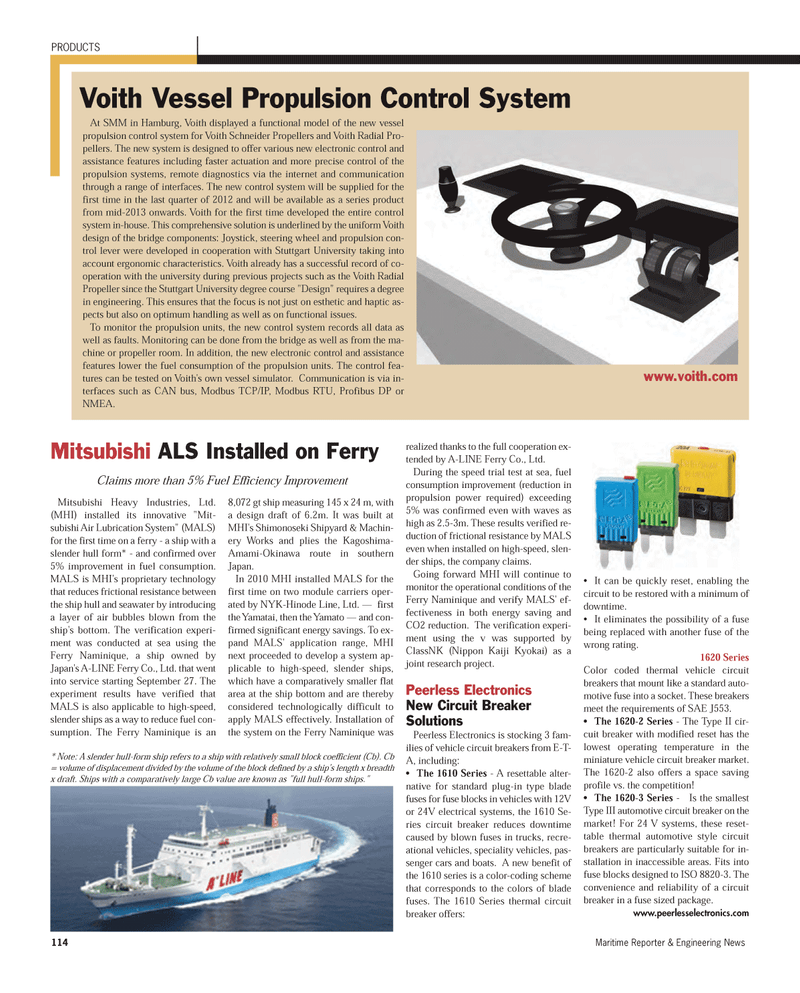
Page 114: of Maritime Reporter Magazine (November 2012)
Workboat Annual
Read this page in Pdf, Flash or Html5 edition of November 2012 Maritime Reporter Magazine
PRODUCTS114Maritime Reporter & Engineering News Mitsubishi Heavy Industries, Ltd. (MHI) installed its innovative "Mit- subishi Air Lubrication System" (MALS) for the first time on a ferry - a ship with a slender hull form* - and confirmed over 5% improvement in fuel consumption. MALS is MHI's proprietary technologythat reduces frictional resistance betweenthe ship hull and seawater by introducing a layer of air bubbles blown from the ship's bottom. The verification experi- ment was conducted at sea using the Ferry Naminique, a ship owned by Japan's A-LINE Ferry Co., Ltd. that went into service starting September 27. The experiment results have verified that MALS is also applicable to high-speed,slender ships as a way to reduce fuel con- sumption. The Ferry Naminique is an 8,072 gt ship measuring 145 x 24 m, witha design draft of 6.2m. It was built at MHI's Shimonoseki Shipyard & Machin- ery Works and plies the Kagoshima- Amami-Okinawa route in southern Japan.In 2010 MHI installed MALS for thefirst time on two module carriers oper- ated by NYK-Hinode Line, Ltd. ? first the Yamatai, then the Yamato ? and con- firmed significant energy savings. To ex- pand MALS' application range, MHInext proceeded to develop a system ap- plicable to high-speed, slender ships,which have a comparatively smaller flat area at the ship bottom and are therebyconsidered technologically difficult to apply MALS effectively. Installation of the system on the Ferry Naminique was realized thanks to the full cooperation ex- tended by A-LINE Ferry Co., Ltd. During the speed trial test at sea, fuelconsumption improvement (reduction in propulsion power required) exceeding 5% was confirmed even with waves as high as 2.5-3m. These results verified re- duction of frictional resistance by MALSeven when installed on high-speed, slen- der ships, the company claims. Going forward MHI will continue to monitor the operational conditions of theFerry Naminique and verify MALS' ef- fectiveness in both energy saving and CO2 reduction. The verification experi- ment using the v was supported by ClassNK (Nippon Kaiji Kyokai) as a joint research project.Peerless Electronics New Circuit Breaker SolutionsPeerless Electronics is stocking 3 fam- ilies of vehicle circuit breakers from E-T- A, including:The 1610 Series - A resettable alter- native for standard plug-in type blade fuses for fuse blocks in vehicles with 12V or 24V electrical systems, the 1610 Se-ries circuit breaker reduces downtime caused by blown fuses in trucks, recre- ational vehicles, speciality vehicles, pas- senger cars and boats. A new benefit of the 1610 series is a color-coding scheme that corresponds to the colors of bladefuses. The 1610 Series thermal circuit breaker offers: It can be quickly reset, enabling the circuit to be restored with a minimum ofdowntime. It eliminates the possibility of a fuse being replaced with another fuse of thewrong rating. 1620 SeriesColor coded thermal vehicle circuit breakers that mount like a standard auto- motive fuse into a socket. These breakers meet the requirements of SAE J553.The 1620-2 Series - The Type II cir- cuit breaker with modified reset has the lowest operating temperature in the miniature vehicle circuit breaker market. The 1620-2 also offers a space saving profile vs. the competition! The 1620-3 Series - Is the smallestType III automotive circuit breaker on the market! For 24 V systems, these reset- table thermal automotive style circuit breakers are particularly suitable for in- stallation in inaccessible areas. Fits intofuse blocks designed to ISO 8820-3. The convenience and reliability of a circuit breaker in a fuse sized package. www.peerlesselectronics.com Voith Vessel Propulsion Control System At SMM in Hamburg, Voith displayed a functional model of the new vessel propulsion control system for Voith Schneider Propellers and Voith Radial Pro- pellers. The new system is designed to offer various new electronic control and assistance features including faster actuation and more precise control of the propulsion systems, remote diagnostics via the internet and communicationthrough a range of interfaces. The new control system will be supplied for the first time in the last quarter of 2012 and will be available as a series product from mid-2013 onwards. Voith for the first time developed the entire control system in-house. This comprehensive solution is underlined by the uniform Voith design of the bridge components: Joystick, steering wheel and propulsion con- trol lever were developed in cooperation with Stuttgart University taking into account ergonomic characteristics. Voith already has a successful record of co- operation with the university during previous projects such as the Voith Radial Propeller since the Stuttgart University degree course "Design" requires a degree in engineering. This ensures that the focus is not just on esthetic and haptic as- pects but also on optimum handling as well as on functional issues. To monitor the propulsion units, the new control system records all data as well as faults. Monitoring can be done from the bridge as well as from the ma- chine or propeller room. In addition, the new electronic control and assistance features lower the fuel consumption of the propulsion units. The control fea- tures can be tested on Voith's own vessel simulator. Communication is via in- terfaces such as CAN bus, Modbus TCP/IP, Modbus RTU, Profibus DP or NMEA.www.voith.com Mitsubishi ALS Installed on FerryClaims more than 5% Fuel Efficiency Improvement * Note: A slender hull-form ship refers to a ship with relatively small block coefficient (Cb). Cb = volume of displacement divided by the volume of the block defined by a ship's length x breadth x draft. Ships with a comparatively large Cb value are known as "full hull-form ships." MR#11 (114--121):MR Template 11/6/2012 11:52 AM Page 114

 113
113

 115
115
